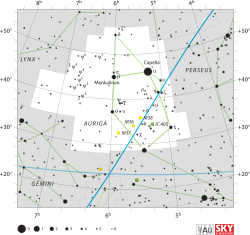|
| 19 Aurigae |  | Observationsdata
Epok: J2000.0 |
|---|
| Stjärnbild | Kusken |
|---|
| Rektascension | 05t 20m 00,92092s[1] |
|---|
| Deklination | +33° 57′ 29,0049″[2] |
|---|
Skenbar magnitud ( ) ) | +5,05[3] 5,03 –5,09 (V)[4] |
|---|
| Stjärntyp |
|---|
| Spektraltyp | A5 II+[5] |
|---|
| U–B | +0,42[6] |
|---|
| B–V | 0,287 ± 0,004[7] |
|---|
| Variabeltyp | Variabel stjärna (E:)[4] |
|---|
| Astrometri |
|---|
Radialhastighet ( ) ) | -4,3 ± 0,9[3] km/s |
|---|
| Egenrörelse (µ) | RA: -0,119 ± 0,304[1] mas/år
Dek.: -4,057 ± 0,219[1] mas/år |
|---|
Parallax ( ) ) | 0,9119 ± 0,1885[1] |
|---|
| Avstånd | ca 3 600 lå (ca 1 100 pc) |
|---|
Absolut magnitud ( ) ) | -3,97[8] |
|---|
| Detaljer |
|---|
| Massa | 7,8 ± 0,5[6] M☉ |
|---|
| Radie | 15[9] R☉ |
|---|
| Luminositet | 7 057[10] L☉ |
|---|
| Temperatur | 8 300 ± 100[11] K |
|---|
| Metallicitet | -0,19(Fe/H)[3]dex |
|---|
| Vinkelhastighet | 8,0[12] km/s |
|---|
| Ålder | 36,0 ± 2,9[6] miljoner år |
|---|
| Andra beteckningar |
|---|
| GEN# +1.00034578, 2MASS J05200092+3357290, TYC 2398-1609-1, AG+33 498, GSC 02398-01609, NSV 1925, UBV 5056, ALS 8273, HD 34578, PPM 70210, UBV M 10815, BD+33 1013, HIC 24879, ROT 761, uvby98 100034578, CSV 100474, HIP 24879, SAO 57906, WEB 4819, FK5 2399, HR 1740, SKY# 8436, YPAC 62, GC 6515, IRAS 05167+3354, ZI 367, AAVSO 0520+34B, GCRV 3171, LS V +33 10, TD1 4371, Gaia DR2 181259753177437568[13] |
19 Aurigae, som är stjärnans Flamsteed-beteckning, är en ensam stjärna[14] i den sydöstra delen av stjärnbilden Kusken.[13] Den har en genomsnittlig skenbar magnitud på ca 5,05[3] och är svagt synlig för blotta ögat där ljusföroreningar ej förekommer. Baserat på parallaxmätning inom Hipparcosuppdraget på ca 0,91[1] mas, beräknas den befinna sig på ett avstånd på ca 3 600 ljusår (ca 1 100 parsek) från solen. Den rör sig närmare solen med en heliocentrisk radialhastighet på ca -4,3 km/s.[3]
Egenskaper
19 Aurigae är en vit till blå ljusstark jättestjärna av spektralklass A5 II+.[5] Den har en massa som är ca 8[6] solmassor, en radie som är ca 15[9] solradier och utsänder ca 7 000[10] gånger mera energi än solen från dess fotosfär vid en effektiv temperatur på ca 8 300 K.[1]
19 Aurigae är en misstänkt variabel stjärna,[4] som varierar mellan visuell magnitud +5,03 och 5,09 utan fastställd periodicitet.[4][15]
Se även
Referenser
- Den här artikeln är helt eller delvis baserad på material från engelskspråkiga Wikipedia, 19 Aurigae, 24 februari 2020.
Noter
- ^ [a b c d e f] Brown, A. G. A.; et al. (Gaia collaboration) (August 2018). "Gaia Data Release 2: Summary of the contents and survey properties". Astronomy & Astrophysics. 616. A1. arXiv:1804.09365. Bibcode:2018A&A...616A...1G. doi:10.1051/0004-6361/201833051. Gaia DR2 record for this source at VizieR.
- ^ ”Basic data: V* 19 Aur – Variable Star” (på engelska). Centre de Données astronomiques de Strasbourg. http://simbad.u-strasbg.fr/simbad/sim-basic?Ident=19+Aur&submit=SIMBAD+search. Läst 30 januari 2019.
- ^ [a b c d e] Anderson, E.; Francis, Ch. (2012), "XHIP: An extended hipparcos compilation", Astronomy Letters, 38 (5): 331, arXiv:1108.4971, Bibcode:2012AstL...38..331A, doi:10.1134/S1063773712050015.
- ^ [a b c d] ”NSV 1925” (på engelska). The International Variable Star Index. AAVSO – American Association of Variable Star Observers. https://www.aavso.org/vsx/index.php?view=detail.top&oid=40549. Läst 30 januari 2019.
- ^ [a b] Gray, R. O.; et al. (2001), "The Physical Basis of Luminosity Classification in the Late A-, F-, and Early G-Type Stars. I. Precise Spectral Types for 372 Stars", The Astronomical Journal, 121 (4): 2148, Bibcode:2001AJ....121.2148G, doi:10.1086/319956.
- ^ [a b c d] Tetzlaff, N.; et al. (January 2011), "A catalogue of young runaway Hipparcos stars within 3 kpc from the Sun", Monthly Notices of the Royal Astronomical Society, 410 (1): 190–200, arXiv:1007.4883, Bibcode:2011MNRAS.410..190T, doi:10.1111/j.1365-2966.2010.17434.x.
- ^ van Leeuwen (2007). ”Hipparcos, the New Reduction” (på engelska). http://vizier.u-strasbg.fr/viz-bin/VizieR-5?-out.add=.&-source=I/311/hip2&HIP=24879. Läst 30 januari 2019.
- ^ https://www.universeguide.com/star/19aurigae. Hämtad 2020-02-24.
- ^ [a b] Pasinetti Fracassini, L. E.; et al. (February 2001), "Catalogue of Apparent Diameters and Absolute Radii of Stars (CADARS)", Astronomy and Astrophysics (Third ed.), 367: 521–524, arXiv:astro-ph/0012289, Bibcode:2001A&A...367..521P, doi:10.1051/0004-6361:20000451.
- ^ [a b] Hohle, M. M.; et al. (April 2010), "Masses and luminosities of O- and B-type stars and red supergiants", Astronomische Nachrichten, 331 (4): 349, arXiv:1003.2335, Bibcode:2010AN....331..349H, doi:10.1002/asna.200911355.
- ^ Lyubimkov, Leonid S.; et al. (February 2010), "Accurate fundamental parameters for A-, F- and G-type Supergiants in the solar neighbourhood", Monthly Notices of the Royal Astronomical Society, 402 (2): 1369–1379, arXiv:0911.1335, Bibcode:2010MNRAS.402.1369L, doi:10.1111/j.1365-2966.2009.15979.x.
- ^ Lyubimkov, Leonid S.; et al. (2015), "Carbon abundance and the N/C ratio in atmospheres of A-, F- and G-type supergiants and bright giants", Monthly Notices of the Royal Astronomical Society, 446 (4): 3447, arXiv:1411.2722, Bibcode:2015MNRAS.446.3447L, doi:10.1093/mnras/stu2299
- ^ [a b] "19 Aur". SIMBAD. Centre de données astronomiques de Strasbourg. Hämtad 2019-05-21.
- ^ Eggleton, P. P.; Tokovinin, A. A. (September 2008), "A catalogue of multiplicity among bright stellar systems", Monthly Notices of the Royal Astronomical Society, 389 (2): 869–879, arXiv:0806.2878, Bibcode:2008MNRAS.389..869E, doi:10.1111/j.1365-2966.2008.13596.x.
- ^ Chistyakov, Yu. N.; Sokolov, N. A. (November 1999), "On the Variability of 19 Aurigae as Observed by the Hipparcos Satellite", Information Bulletin on Variable Stars, 4808: 1, Bibcode:1999IBVS.4808....1C.
Externa länkar
|





